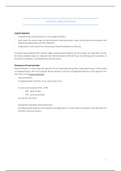CHAPTER 8 : BRAND ACTIVATION
Chapter objectives
- Understand why brand activation is increasingly important
- Learn about the various types of brand activation (sales promotions, point-of-purchase communication and
experiential approaches) and their objectives
- Understand to what extent the various types of brand activation are effective
If products move towards their maturity stage, passive communications are not enough. You need sales, and for
this brand activation plays an important role. Brand activation shifts the focus of marketing communications to
the heart of marketing : stimulating the purchase process.
Dimensions of brand activation
Brand activation is in many ways the opposite of mass media advertising. Mass media advertising is mainly aimed
at changing things in the mind of people. Brand activation is aimed at changing the behaviour of the people in the
short term. It has three components :
- Sales promotions
It is giving people incentives to buy your product now.
- In-store communication (POS – POP)
- POS : point of sales
- POP : point of purchase
Can also be near store!
- Experiential marketing / brand experience
Providing meanful experiences for people by bringing them in contact with your product so that they become
inclined to buy your product.
1
,Sales promotions
Companies want to have quick results, and cannot wait for the long-term effects. There is a mentality that the
return on investment should be fast. But this you cannot do with the classical media advertising, but you can do it
with the sales promotions. E.g. this week you get a 10% discount.
Sales promotions are thus a category of techniques aimed at increasing sales in the short run, and therefore mostly
used for a short period of time. -> action communications
The effectiveness of promotions is often attributed to the operant conditioning mechanism : behaviour that is
rewarded serves to reinforce future behaviour. Sales promotions are, as a result of this type of conditioning,
quickly recognised by consumers as a reinforcer, a reward, based on their past experience. Once this reward
feeling is conditioned, it becomes the standard behavioural response. Sales promotions lead to habit formation in
other words. Therefore promotions should be important enough.
Priming is also a mechanism that may explain why promotions work : a short exposure to a promotional ‘prime’
may motivate people to buy (more of) a product that is on promotion.
THE GROWING IMPORTANCE OF SALES PROMOTIONS
What does affect the increasing use of sales promotions?
- Communications clutter and ad avoidance
In advertising there is an increasing clutter, there is more and more advertising everywhere (offline and
online), and as a consequence it becomes less effective. People even actively avoid it or they don’t pay
attention to it (banner blindness). Therefore companies shift their budgets from mass media communications
to sales promotions, since they can activate the people directly and measure the result immediately.
- Lack of differentiation
In the mind of consumers they are equally good. By means of advertising campaigns you cannot usually make
yourself unique, so therefore sales promotion is used to convince people. They have an evoked set in their
mind, and mainly they will choose the brand that is in promotion
2
, - Distribution channel power
Distribution channels have the contact with the client, they have the buildings, they organise the shelfs.
Distribution channels love sales promotions, since everyone goes to the supermarket at that time, therefore
there is an increasing pressure on producers to do sales. This has changes a bit with the start of e-shops, but
you also see a lot of sales promotions in the e-shops, since all the other factors keep on fuelling the increasing
use of sales promotions.
- Measurability
If you say only this week this promotion, you can really measure the effects at the end of the week.
Traditional advertising is often aimed at obtaining intermediate effects, such as awareness and favourable
attitudes, eventually leading to increased sales. Promotions are aimed at immediate behavioural response.
- Short-term orientedness
When you ask a company about its strategic perspective, this would be for one year. In the old days it would
be 3-5 years. Often sales promotions are also used to reach certain benchmarks.
- Buying decision taken in store
People go to the store and they have a vague shopping list in mind, but in the store they often decide what
they are going to buy. They have an idea about the products, not about the brands. In store you often see
sales promotions, so then you will buy that. The purchasing decisions are essentially impulse-buying decisions.
- Declining brand loyalty
You cannot count upon consumers becoming loyal with you without any incentive. You must seduce
consumers on a regular basis with incentives. They are becoming increasingly price-conscious.
Also consumers are no longer loyal to one single brand in a product category -> portfolio buyers. They choose
from the brands in their mental portfolio when they are in the shop, and when something is on sale, they will
probably go for that particular brand.
All these factors lead to situations in which sales promotions become more important : they have an increasing
share in marketing communications budgets and marketing communications activities.
3





